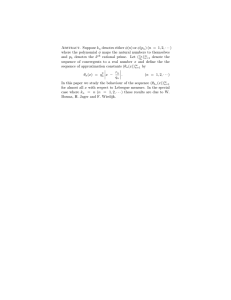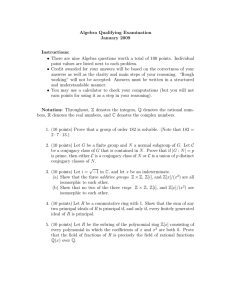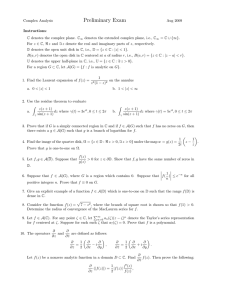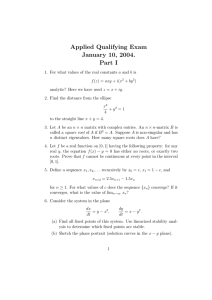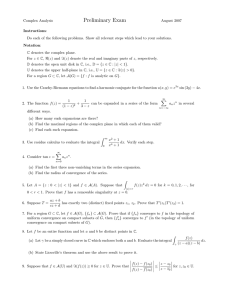Part I
advertisement
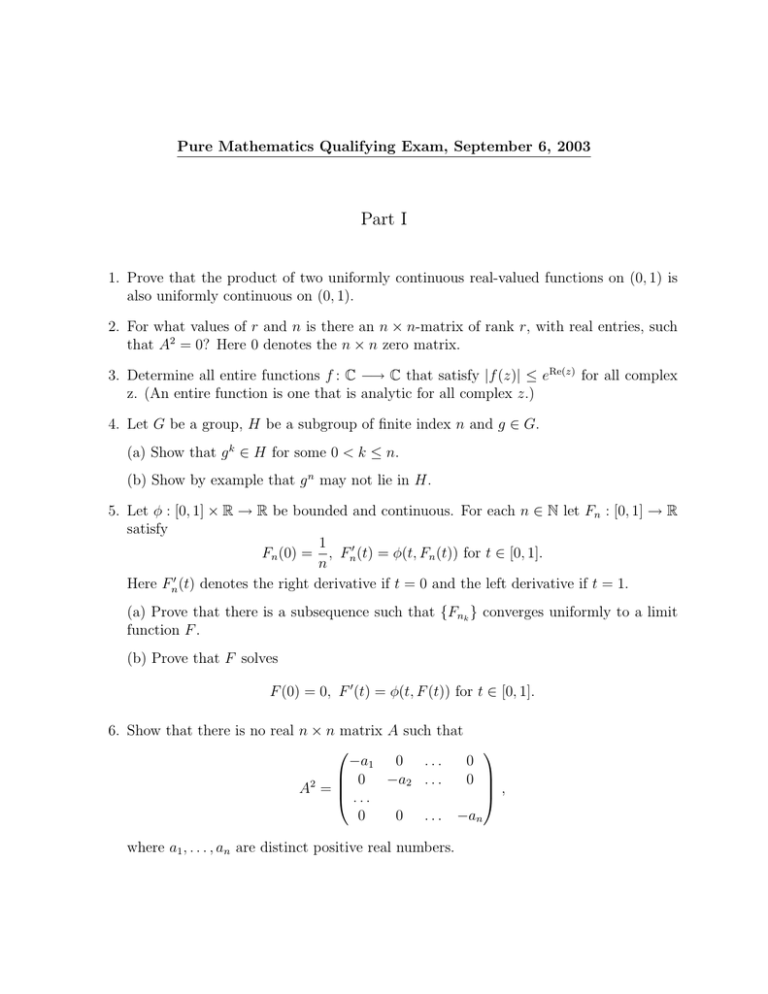
Pure Mathematics Qualifying Exam, September 6, 2003
Part I
1. Prove that the product of two uniformly continuous real-valued functions on (0, 1) is
also uniformly continuous on (0, 1).
2. For what values of r and n is there an n × n-matrix of rank r, with real entries, such
that A2 = 0? Here 0 denotes the n × n zero matrix.
3. Determine all entire functions f : C −→ C that satisfy |f (z)| ≤ eRe(z) for all complex
z. (An entire function is one that is analytic for all complex z.)
4. Let G be a group, H be a subgroup of finite index n and g ∈ G.
(a) Show that g k ∈ H for some 0 < k ≤ n.
(b) Show by example that g n may not lie in H.
5. Let φ : [0, 1] × R → R be bounded and continuous. For each n ∈ N let Fn : [0, 1] → R
satisfy
1
Fn (0) = , Fn0 (t) = φ(t, Fn (t)) for t ∈ [0, 1].
n
0
Here Fn (t) denotes the right derivative if t = 0 and the left derivative if t = 1.
(a) Prove that there is a subsequence such that {Fnk } converges uniformly to a limit
function F .
(b) Prove that F solves
F (0) = 0, F 0 (t) = φ(t, F (t)) for t ∈ [0, 1].
6. Show that there is no real n × n matrix A such that
−a1 0 . . .
0
0 −a2 . . .
0
,
A2 =
...
0
0 . . . −an
where a1 , . . . , an are distinct positive real numbers.
Pure Mathematics Qualifying Exam, September 6, 2003
Part II
Z
∞
7. Use contour integration to evaluate the integral
−∞
sin πx
dx.
+x+1
x2
8. Let Z be the ring of integers, p a prime, and Fp = Z/pZ the field with p elements. Let
x be an indeterminant, and set R1 = Fp [x]/(x2 − 2), R2 = Fp [x]/(x2 − 3). Determine
whether the rings R1 and R2 are isomorphic in each of the following cases:
(a) p = 2,
(b) p = 5,
(c) p = 11.
9. Let C be a simple closed C 1 -curve in R2 with the positive orientation enclosing a region
2
2
D. Assume
R D has area 2 and centroid (3, 4). Let F(x, y) = (y , x + 3x). Find the line
integral C F · ds.
10. Let A be a nilpotent n × n-matrix, i.e., Am = 0 for some m ≥ 1, where 0 is the
n × n-zero matrix. Prove or disprove the following assertions:
(a) An = 0,
(b) det(A + I) = 1. Here I denotes the n × n identity matrix.
(c) det(D + A) = det(D) for every diagonal n × n-matrix D?
11. (a) Show that all the zeros of the polynomial f (z) = z 8 −3z +1 lie in the disk |z| < 5/4.
(b) How many zeros does f have in the unit circle?
12. A complex number is called algebraic if it is a root of a non-zero polynomial with
integer coefficients. Show that a = sin(ro ) is an algebraic number for every rational
πr
number r. Here ro denotes the angle of r degrees or, equivalently, of 180
radians.
